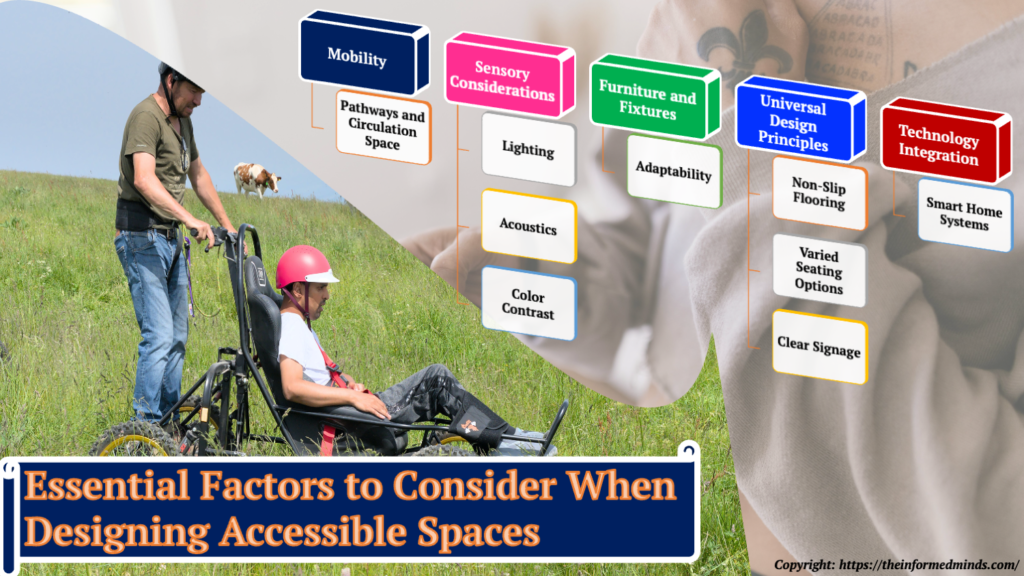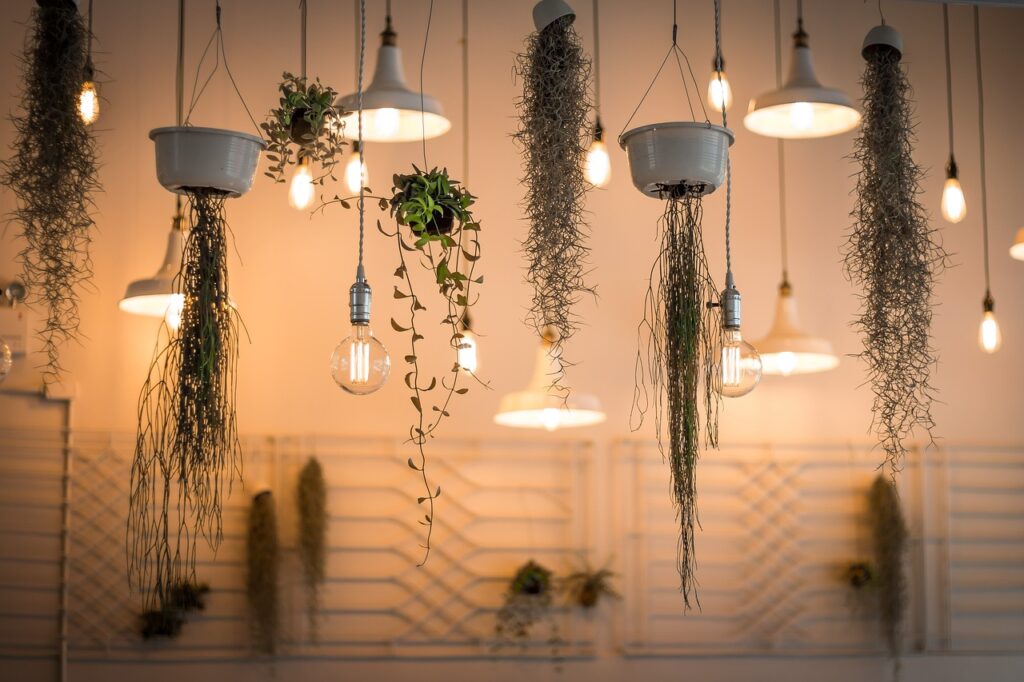In today’s design landscape, inclusivity is not just a trend; it’s a fundamental principle that should be embedded in every aspect of our lives. When it comes to interior design, creating spaces that are accessible to everyone, including those with disabilities, is not only a legal requirement but also a moral imperative. In this blog post, we’ll explore the importance of designing for accessibility and how interior designers can accommodate those with disabilities.
1. Understanding Accessibility in Interior Design
Accessibility in interior design refers to the practice of creating environments that can be used and accessed by people of all abilities, including those with physical, sensory, and cognitive disabilities. It involves removing barriers and providing accommodations to ensure that everyone can navigate and use a space comfortably and safely.
2. Key Considerations for Designing Accessible Spaces

2.1 Mobility
Pathways and Circulation Space: Designing accessible pathways involves ensuring that there is enough space for individuals using wheelchairs or mobility aids to move comfortably throughout the space. This includes considering the width of doorways, hallways, and corridors to accommodate wheelchair turning radiuses and avoiding obstacles that may obstruct movement.
2.2 Sensory Considerations
- Lighting: Proper lighting is crucial for individuals with visual impairments. Designers should ensure that spaces are well-lit and free from glare to facilitate navigation and reduce the risk of accidents.
- Acoustics: People with sensory sensitivities may find loud or echoic environments overwhelming. Designers should consider incorporating sound-absorbing materials and acoustic treatments to create quieter, more comfortable spaces.
- Color Contrast: Utilizing high-contrast color schemes can aid individuals with low vision in distinguishing between different elements within a space. Contrast between walls, floors, furniture, and signage helps improve visibility and legibility.
2.3 Furniture and Fixtures
Adaptability: Selecting furniture and fixtures that are adaptable and easy to use promotes inclusivity. Adjustable-height tables, chairs with armrests, and grab bars in bathrooms enhance usability for individuals with mobility limitations.
2.4 Universal Design Principles
- Non-Slip Flooring: Installing non-slip flooring reduces the risk of slips and falls for all occupants, particularly those with mobility challenges.
- Varied Seating Options: Offering a variety of seating options accommodates individuals with different needs and preferences. This includes providing chairs with and without armrests, as well as benches and stools of varying heights.
- Clear Signage: Clear, well-placed signage with large fonts and high contrast aids navigation for individuals with visual impairments and cognitive disabilities.
2.5 Technology Integration
Smart Home Systems: Implementing smart home technologies allows individuals to control various aspects of their environment, such as lighting, temperature, and security, using voice commands or mobile devices. This promotes independence and enhances accessibility for people with disabilities.
3. Benefits of Designing for Accessibility

3.1 Inclusivity
Designing for accessibility fosters an inclusive environment where everyone, regardless of ability, feels welcome and valued. It promotes a sense of belonging and ensures that no one is left out or marginalized.
3.2 Compliance
Meeting accessibility standards not only fulfills legal requirements but also demonstrates a commitment to social responsibility and equality. It reflects positively on businesses and organizations, enhancing their reputation and credibility.
3.3 Enhanced User Experience
Accessible design improves the overall user experience for all occupants, leading to increased comfort, convenience, and satisfaction. By considering the diverse needs of users, designers can create environments that are functional, intuitive, and enjoyable to use.
3.4 Future-Proofing
Designing with accessibility in mind future-proofs spaces against evolving needs and demographics. As populations age and demographics shift, accessible design ensures that spaces remain relevant, adaptable, and accommodating to a diverse range of users.
4. Challenges and Solutions

While designing for accessibility poses challenges, such as budget constraints and space limitations, creative solutions can address these obstacles. Collaboration with accessibility experts, leveraging technology, and prioritizing inclusive design from the outset can help overcome these challenges and create truly accessible environments.
Conclusion
Incorporating accessibility into interior design is not just a moral obligation; it’s a reflection of our commitment to equality and inclusion. By adopting inclusive design principles and prioritizing accessibility, interior designers have the power to transform spaces into welcoming environments for everyone, regardless of ability. Let’s strive to create spaces that empower individuals with disabilities and celebrate the diversity of human experience.
By embracing accessibility in interior design, we pave the way for a more inclusive and equitable future where everyone can thrive. Let’s design with accessibility in mind, one space at a time. Remember, the key to impactful design lies in its ability to uplift and empower every individual who interacts with it. Let’s design for inclusion, let’s design for accessibility.
Frequently Asked Questions
Q1: What is accessible design for people with disabilities?
A: Accessible design for people with disabilities involves creating environments, products, and services that can be accessed, understood, and used by individuals with diverse abilities. It aims to remove barriers and promote inclusivity, ensuring that people with disabilities can fully participate in various activities and experiences.
Q2: How is accessibility relevant in interior design?
A: Accessibility is highly relevant in interior design as it ensures that spaces are usable and welcoming for individuals with disabilities. By incorporating accessible design principles, interior designers can create environments that accommodate diverse needs, promote independence, and enhance the overall quality of life for occupants.
Q3: How do you create an inclusive design and designing for accessibility?
A: Creating an inclusive design involves considering the needs and preferences of all users, regardless of their abilities or backgrounds. Designing for accessibility entails incorporating features and accommodations that facilitate access and usability for individuals with disabilities. By prioritizing inclusivity and accessibility, designers can create environments that are welcoming, functional, and equitable for everyone.
Q4: How to make buildings more accessible for people with disabilities?
A: Making buildings more accessible for people with disabilities involves implementing various design strategies and features, such as ramps, elevators, wide doorways, tactile signage, accessible parking spaces, and barrier-free pathways. Additionally, ensuring that facilities like restrooms, kitchens, and common areas are designed with accessibility in mind enhances usability and promotes inclusivity.
Q5: What is an example of accessible interior design?
A: An example of accessible interior design includes incorporating features like lever-style door handles, grab bars in bathrooms, adjustable-height countertops, non-slip flooring, and wide corridors and hallways to accommodate wheelchair users and individuals with mobility impairments. These design elements enhance usability and promote independence for occupants with disabilities.
Q6: What are the 4 principles of accessible design?
A: The four principles of accessible design, as outlined in the Web Content Accessibility Guidelines (WCAG), include perceivable, operable, understandable, and robust. These principles emphasize the importance of making content and environments perceivable to all users, operable with various assistive technologies, understandable in their presentation and functionality, and robust enough to withstand technological changes and adapt to diverse user needs.
Q7: How to design a room for a disabled person?
A: Designing a room for a disabled person involves considering their specific needs and limitations. This may include providing ample space for maneuverability, installing grab bars and handrails for support, ensuring non-slip flooring, incorporating adjustable-height features, and utilizing sensory-friendly elements such as proper lighting and color contrast.
Q8: What are three reasons for designing for accessibility?
A: Three reasons for designing for accessibility include promoting inclusivity and equity, meeting legal requirements and standards, and enhancing user experience and satisfaction. Designing for accessibility not only benefits individuals with disabilities but also creates environments that are more functional, intuitive, and accommodating for all users.
Q9: How do you implement accessibility in design?
A: Implementing accessibility in design involves considering accessibility standards and guidelines, conducting user research and testing, collaborating with accessibility experts, and incorporating inclusive design principles from the outset of the design process. It requires a proactive approach to identify and address barriers to access and usability for individuals with disabilities.
Q10: What is an example of inclusive design for disability?
A: An example of inclusive design for disability is the development of curb cuts, which were originally designed to assist individuals using wheelchairs but also benefit people with strollers, walkers, or mobility aids. This demonstrates how designing for specific disabilities can lead to solutions that enhance accessibility and usability for a broader range of users.
Q11: What considerations should be made for accessibility and inclusivity in design?
A: Considerations for accessibility and inclusivity in design include providing clear signage and wayfinding, ensuring adequate space for maneuverability, incorporating tactile and sensory elements, offering multiple modes of communication, and considering the diverse needs and preferences of users throughout the design process.
Q12: What is the main difference between inclusive design and accessible design?
A: The main difference between inclusive design and accessible design lies in their scope and approach. Inclusive design aims to create environments, products, and experiences that accommodate the needs of all users, regardless of their abilities or backgrounds, while accessible design focuses specifically on removing barriers and providing accommodations for individuals with disabilities.
Q13: How do you accommodate people with disabilities?
A: Accommodating people with disabilities involves providing reasonable adjustments and accommodations to ensure equal access and participation in various activities and environments. This may include offering assistive technologies, modifying physical spaces, providing alternative formats for information, and fostering an inclusive and supportive atmosphere.
Q14: Why is it important to accommodate people with disabilities?
A: It is important to accommodate people with disabilities to promote equality, dignity, and social inclusion. By providing accommodations, individuals with disabilities can fully participate in society, access opportunities, and exercise their rights on an equal basis with others.
Q15: Why is accessibility important for disabled people?
A: Accessibility is important for disabled people as it enables them to access and engage with various environments, products, and services on an equal basis with others. It promotes independence, autonomy, and inclusion, allowing individuals with disabilities to live fulfilling and meaningful lives without encountering unnecessary barriers or limitations.

